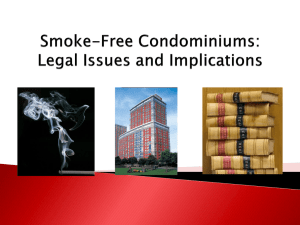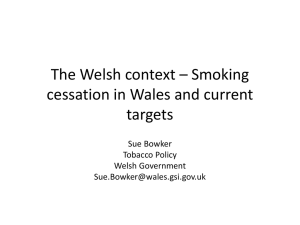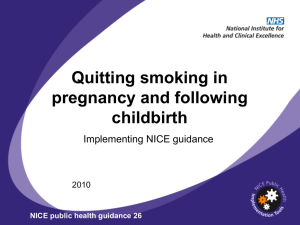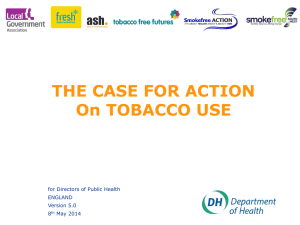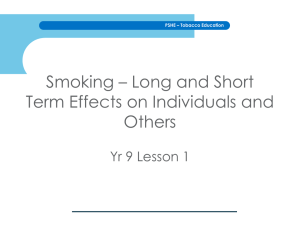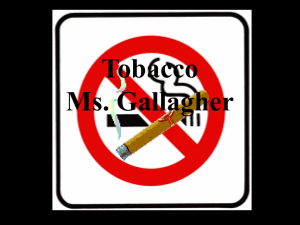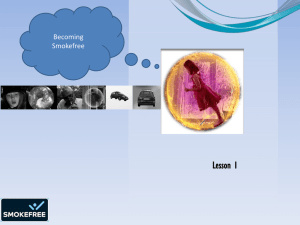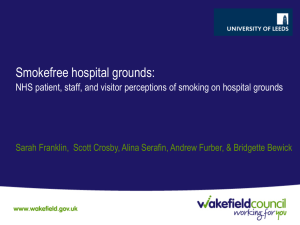Implementation of Scotland`s Future is Smoke Free
advertisement
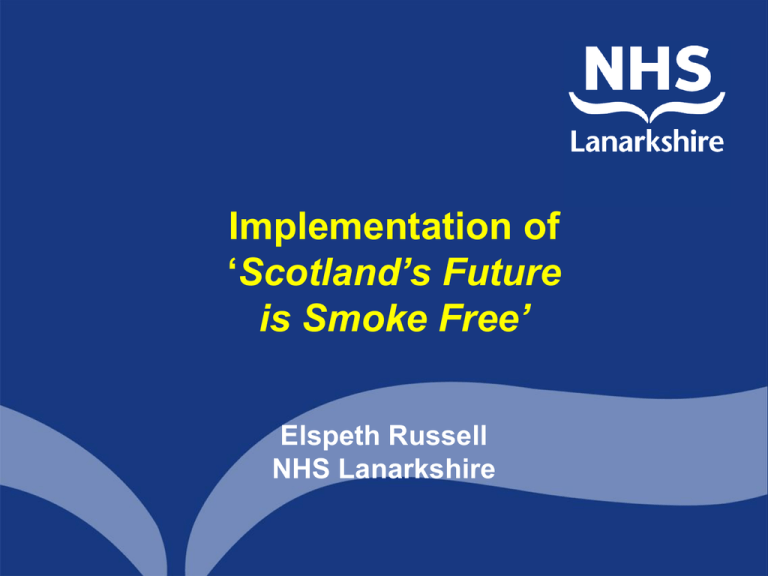
Implementation of ‘Scotland’s Future is Smoke Free’ Elspeth Russell NHS Lanarkshire Overview • Setting the context • Scotland’s Future is Smoke Free (2008) • Local response to the national plan • Reflection Smoking Kills! • Single most preventable cause of ill health and premature death • Quarter of all Scotland’s deaths attributable to smoking • Maternal smoking is the most preventable cause of death and illness in foetus and infants • Conclusive evidence that exposure to second hand smoke causes disease and death Why people smoke Social, economic, personal and political influences all play an important part in determining patterns of smoking prevalence and cessation. Although drug effects underpin the behaviour, family and wider social influences are often critical in determining who starts smoking, who gives up and who continues” Jarvis, M. (2004) Why people smoke British Medical Journal, 328, 277-279 • Evidence shows need for approaches which work across all levels to discourage people from starting to smoke, help smokers to stop, create an environment that is free of tobacco smoke, change social climate around smoking Scotland’s Future is Smoke Free (2008) “We will continue to help smokers to quit but recognise that, if smoking is to become a thing of the past, we need to shift the focus towards preventing children and young people starting to smoke in the first place.” • Based on Towards a Future Without Tobacco (2006) • Heavily relies on successful partnership working – the NHS cannot achieve many of the actions on its own • 3 year funding for health boards and local authorities with one year additional funded for 2011/12 Scotland’s Future is Smoke Free (2008) • Set new prevalence targets • 4 key objectives – Educate and promote healthy lifestyles – Reduce the attractiveness of cigarettes – Reduce the availability of cigarettes – Reduce the affordability of cigarettes • Many actions to be enforced through the Tobacco and Primary Medical Services (Scotland) Act 2010 The Lanarkshire approach • Local examples of good practice but uncoordinated • Smoking Prevention Group formed and fixed term post appointed • Nine areas identified and prioritised which balanced national recommendations with local need • Where possible timetabled themed meetings after relevant national events • Virtual network formed – members joined relevant themed meetings only • Problem solving approach to themed meetings • Work plans progressed simultaneously due to tight timescales • Outcomes, outputs and key performance measures agreed and a work plan developed for delivery between January 2010 and March 2012 • Accountability to the Lanarkshire Tobacco Control Strategy Group Smoking Prevention Action Plan: Nine local work streams • Youth Involvement and Consultation • Training and resources • Curriculum development • Smoking Cessation services • Reducing second hand smoke exposure • Smoke Free policies • Enforcement and control • Campaigns and communications • Prevention programmes for key priority groups Youth involvement and consultation • LANDED Peer Education Service commissioned to facilitate youth involvement in the workstreams • Baseline consultation survey completed • Brand for Youth Cessation service developed Training and resources • NHSL Stop Smoking Service and Landed developed and co delivering a one day tobacco awareness course to professionals working with young people • Central library lending facility set up for tobacco resources • Peer education workshop under development Curriculum development: Smoke in your eyes • Review of local tobacco resources and national evidence base and best practice • Virtual sounding board • Aligned to CfE outcomes from P4 onwards • Available on GLOW so easily updated • “ Scott & Hannah” storyline with illustrations • Process evaluation for all schools and detailed evaluation with specific learning communities Youth Stop Smoking Service • • • • • • Text service launched March 2011 Protocol in place for youth staff Flexible support following assessment Existing staff capacity, aiming to utilise skills Stop Smoking Service staff have received Youth training from Council partners Will be reviewed after 6 months Enforcement and control • Both Councils taken forward a range of programmes to control tobacco sales • Met all national targets for test purchasing • Compliance with smoking in public places ban in excess of 99% • Key priorities for future are to increase public awareness of the new Act and addressing smoking in vehicles which come under the legislation Second hand smoke • Community consultation undertaken • Models of best practice – Salford PCT • 3 Healthy Living Centres commissioned to deliver a community led programme using volunteer champions • Focus on community settings including nurseries and schools • Staff training also developed and forms part of core training programme Smoke free policies • Youth settings – 4 pilots – Survey of youth settings • Good practice guidance to be developed • NHSL No Smoking Policy • Workplace no smoking policies Workstreams under development • Communications and campaigns – – – – • Key priority groups – – – – • Social norms campaign in colleges stalled Exploring potential for social norms within workplaces Football clubs Local media ‘ Mapping exercise from each Unit Training modules and youth Stop Smoking Service now in place Lack of evidence base Key area for development 2011/12 working in partnership with Community Learning and Development Reflecting on delivery of Scotland’s Future is Smoke Free Some challenges… – Local Prevention Plan and funding runs to 2012 with only one year of funding thereafter – Need for more collaborative working nationally to build evidence base – Human Resource challenges – capacity, recruitment – NHS focus on HEAT and Efficiency Framework Many opportunities… – Better engagement of partners in this agenda and increased focus on upstream activity – Funding for staff to develop a comprehensive programme, build capacity, and to ensure robust monitoring and evaluation – Programmes developed provide opportunities to increase awareness and referrals to cessation services thus contributing to HEAT – Provided impetus for Lanarkshire Tobacco Control Strategy Thank you for listening Questions? Elspeth Russell Assistant Health Promotion Manager North CHP NHS Lanarkshire Law House Carluke Tel: 01698 377622 elspeth.russell@lanarkshire.scot.nhs.uk



